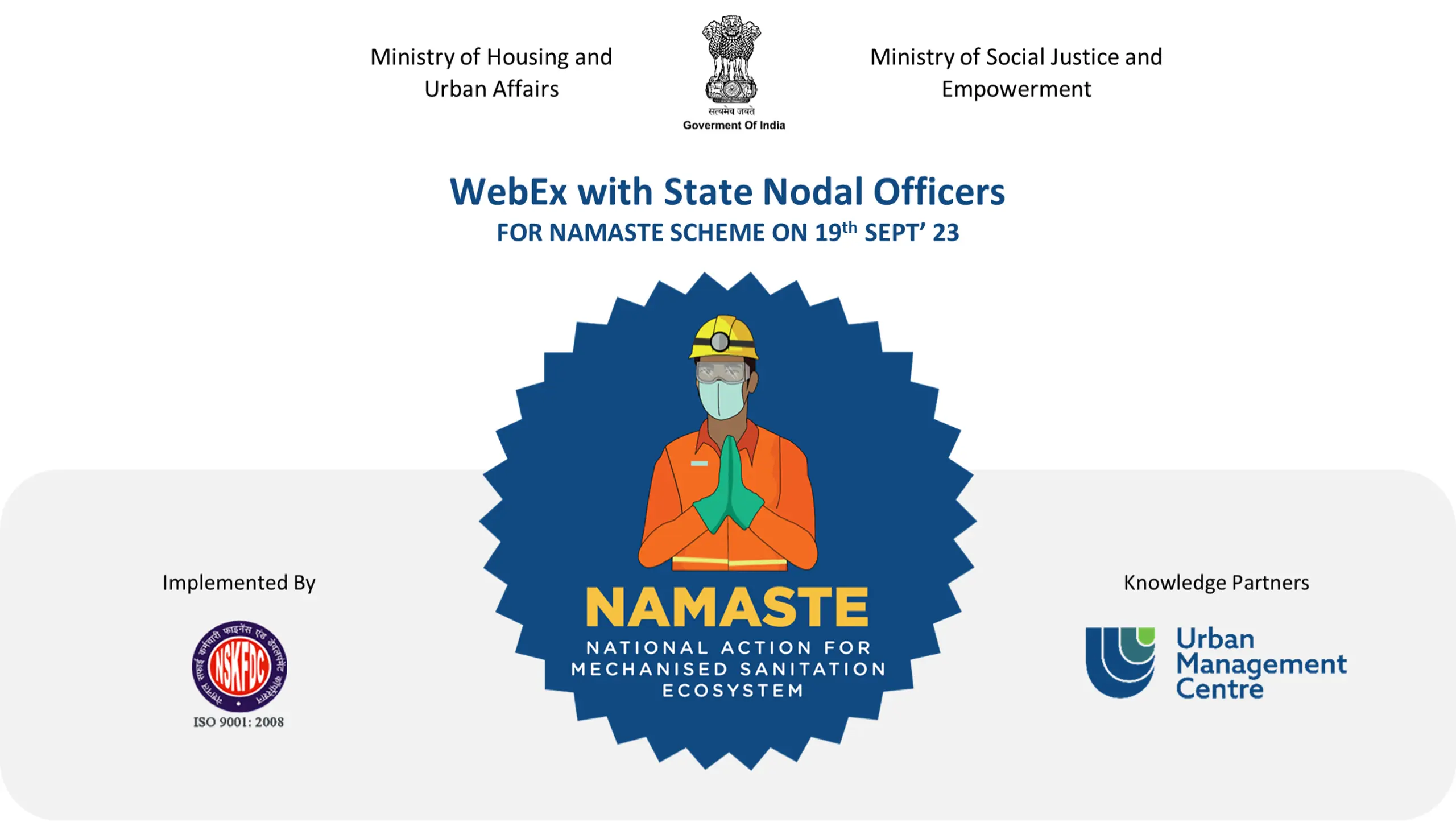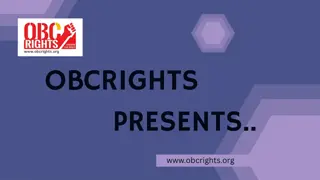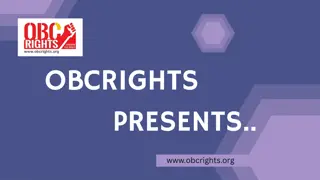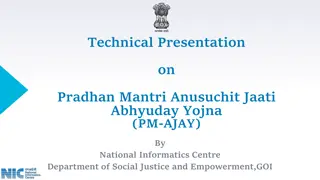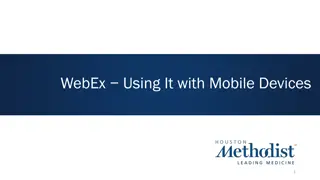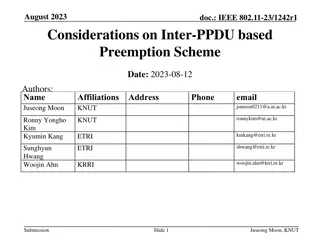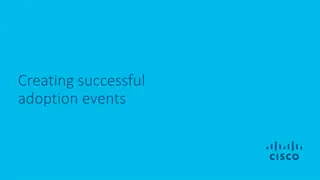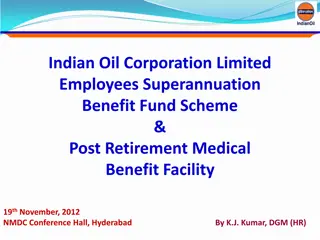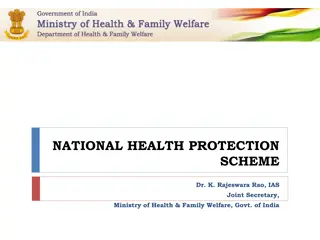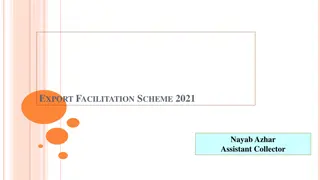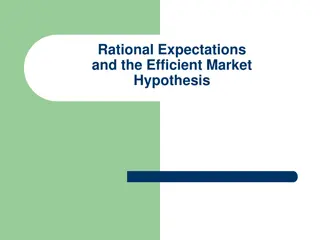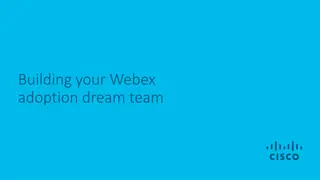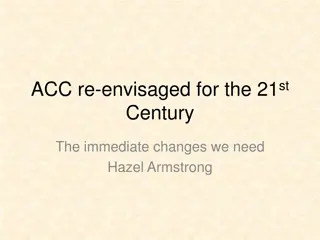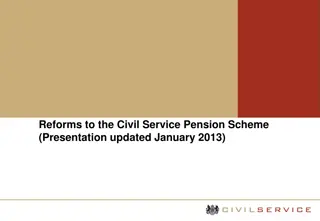NAMASTE Scheme WebEx: State Expectations & Implementation Role
Engage State Nodal Officers for NAMASTE scheme insights, targeting sanitation workers' safety, dignity, and awareness. Elements include health insurance, safety training, equipment subsidies. Collaboration between MoSJE and MoHUA.
Download Presentation

Please find below an Image/Link to download the presentation.
The content on the website is provided AS IS for your information and personal use only. It may not be sold, licensed, or shared on other websites without obtaining consent from the author.If you encounter any issues during the download, it is possible that the publisher has removed the file from their server.
You are allowed to download the files provided on this website for personal or commercial use, subject to the condition that they are used lawfully. All files are the property of their respective owners.
The content on the website is provided AS IS for your information and personal use only. It may not be sold, licensed, or shared on other websites without obtaining consent from the author.
E N D
Presentation Transcript
Ministry of Housing and Urban Affairs Ministry of Social Justice and Empowerment WebEx with State Nodal Officers FOR NAMASTE SCHEME ON 19thSEPT 23 Implemented By Knowledge Partners
Content About NAMASTE Scheme Role and expectations from State for implementation of NAMASTE Profiling Process of SSWs State PMU Appointment 2
National Action for Mechanised Sanitation Ecosystem (NAMASTE) A joint initiative of MoSJE and MoHUA 1 2 3 4 Ensure occupational safety and dignity of sanitation workers Provide access to entitlements livelihoods support to reduce the vulnerabilities of sanitation workers Behavior change amongst stakeholders to demand safe sanitation services Mechanized cleaning of sewer lines and septic tanks Aim Target Group Stakeholders Sewer and Septic Tank Workers (SSWs) MoSJE (NSKFDC) & MoHUA Consumers of Sanitation Services Sewer and Septic Tank Workers Urban Local Bodies (ULBs) Sewer network / maintenance holes Cleaners Septic Tank/pits Cleaners Private Sanitation Service Organizations (PSSOs)
Intended Outcomes of NAMASTE Zero fatalities in sanitation sector No direct contact with human faecal matter Recognition as skilled workers SHG and sanitation enterprises formation Increased awareness among citizens Regulation and Enforcement Access to livelihoods
NAMASTE Components 1. Profiling of SSWs in ULBs through digital tools (~ 1 lakh SSW to be identified) 2. Health Insurance of SSW under PM-JAY 3. Occupational safety training of SSWs and SRUs for NAMASTE 4. Capital Subsidy up to Rs. 5.00 lakh and interest for procurement of Sanitation Related Vehicles/ Equipment 5. Distribution of PPE to SSWs 6. Distribution of safety devices to ERSU 7. IEC Campaign for awareness on SSW safety and dignity State NAMASTE Coordinators: States/UTs would be authorized to engage PMU staff to support the Mission Director of State for implementation of NAMASTE scheme. IT infrastructure: Dedicated NAMASTE portal for scheme implementation and monitoring.
Convergence Of Programmes Of Ministries MoSJE MoHUA DoDWS DPIIT Identification startup in sanitation sectors of potential Profiling of Sewer and Septic tank workers in camp mode through ULBs Sensitisation of ULBs for implementation of NAMASTE and follow up IEC campaign in rural and urban peripheral areas to use services of SRUs convergences of ideas. Promotion among startups for innovation in sanitation sectors PPE kit for surface sewer/septic tanks workers. Provide Data on SSWs and PSSOs at ULB level for profiling New technologies for tough terrains have been used as pilots in States like MTU for onsite desludging of septic tanks. Ensure nomination of RSA in each District. Safety procurement devices and equipment Ensure setting up of SRU in each large ULB. Occupational skilling of surface sewer/septic tanks workers. safety training and SBM(G) Guidelines- to ensure mechanized desludging only States/districts SHG formation of sewer/septic tank workers Providing work assurance to sanitation workers for Sanitation Related Projects. Provision of health insurance under AB-PMJAY MSDE Nomination of Mission Directors (SBM) as State NAMASTE Nodal Officer at State level/ULB level. Occupational safety training of surface sewer / septic tank workers. MSDE to integrate with PMKVY. IEC Campaign Training of sewer entry professionals and SRU staff. PPE for sewer entry professionals. Monitoring of implementation. Coordination with MoHUA and other Ministries. IEC in ULBs. NAMASTE interventions to be evaluated under Swachh Sarvekshan
Role of State Government Constitute working group at State Level and District Level for implementation of NAMSTE Scheme. Appointment of District Collector as RSA in each District. State NAMASTE Nodal Officer may engage State PMU Coordinator who will assist them for effective implementation of NAMASTE .
Role of State NAMASTE Nodal Officer Monitoring the implementation of NAMSTE scheme in the state. Ensure appointment of RSA and establishment of ESRU Appointment of State PMUs as per allocation and provide the details to NSKFDC. Guidelines for appointment PMUs has been shared to Principal Secretaries of States/ UTs. Nomination of ULB level Nodal officer in each ULB for implementation of NAMASTE. Facilitate the process of submission of a city profile through google form link to NSKFDC for all ULBs in the state. *the responsibility of the State NAMASTE Nodal Officer is allotted to the designation and not the person.
Expectations from State S. No Activity Timeline 25thSeptember 2023 onwards 1 Online orientation (WebEx) of enumerators/surveyors of ULBs for conducting profiling of SSWs 30thSeptember 2023 to be completed 2 Appointment of State Level PMU (Status: Only Assam, Odisha, Rajasthan(1 out of 2) and Maharashtra(1 out of 2) have appointed. Confirmation awaited from other States/UTs.) 1stOctober 15thOctober 2023 3 Conducting first profiling fortnight for SSWs
PROFILING PROCESS OF SSWs NAMASTE - TSU, UMC
Why Profiling of SSWs? The objective of the profiling camp is to identify Sewer and Septic Tank Workers (SSWs) who directly deal with faecal matter We have the constitutional mandates, legislations, Supreme Court orders and Human Rights Commission Directives Yet, the invisibility of sanitation workers continues Inclusion of sanitation workers is not possible if we do not have a robust database of workers
Challenges of SSWs Social Issues: Lack of identity and formal recognition of sanitation workforce Lack of awareness and sensitivity for sanitation workers safety among citizens Discrimination in society Lower Literacy levels and lack of opportunities for skill enhancement Social Issues Economic and financial Issues Economic and financial: Lack of skilling and alternate livelihoods opportunities Financial indebtedness Lack of Transparency: Poor contractual mechanisms and lack of SOPs in local governments Lack of convergence amongst stakeholders for enforcement Lack of Transparency Occupational Hazards and Health Issues: Insufficient health and safety measures leading to injury, infection, eye sight, skin & respiratory diseases, mental health issues and death even before reaching the age of retirement Intolerable working environment leading to substance abuse Occupational Hazards and Health Issues
Role of ULBs in Implementation of NAMASTE Profiling of SSWs engaged by ULBs, parastatal agencies, PSSOs, state-level departments, private contractors through profiling camps Occupational safety training of SSWs in usage of PPE, safety devices and handling mechanized cleaning operations Formation of self help groups (SHG) of SSWs for sanitation related livelihood activities Linkages to social and financial entitlements Linkages with livelihoods through SUY scheme for procurement of sanitation related machines and provide continuous work assurance
Profiling Process Flow Validation of the Survey By ULB level NAMASTE Nodal Officer (100%) Enumeration of the SSW by enumerators Generating the Unique ID of the SSW Quality Check of the Survey by NSKFDC/PMU
Role of ULB in Profiling of SSWs Organize City-Level NAMASTE Camps for enumeration of SSWs engaged by ULBs, parastatal agencies, PSSOs, state-level departments and other private contractors Activities at Pre profiling Stage How? Where? Enumeration through NAMASTE Application/Desktop portal A collated list of SSW engaged by ULBs, Parastatal agencies, PSSOs, state-level departments and other private contractors Submit City Profile and Identification of NAMASTE Nodal Officer at city level and Enumerators (Enumerators can be sanitary inspectors, SBM field level staff with digital literacy ) Training of NAMASTE Nodal Officer and Enumerators Seek support from State NAMASTE Project Implementation Unit (PIU) to onboard State level parastatal agencies Determine the number of camps based on population of ULB; extent of sewerage network, and number of septic tanks and distribution of SSWs in the city. 1 enumerator should survey 10 SSWs per day. Issue notification for mandatory attendance of SSWs in camp and share it with parastatal agencies and PSSOs. Budget of the camp: The admissible cost of conducting these camps is Rs.2000 for every 25 SSWs enumerated. Organize profiling camps at ULB offices (ward/ zonal/ central offices or at muster station) or in settlements where majority of SSWs reside. When? Schedule camp at a time which is convenient to the SSWs and PSSOs to attend and does not impact their wages for the day.
Role of ULB in Profiling of SSWs Checklist INFRASTRUCTURE RESOURCES TECHNICAL List of SSWs employed on the payroll, contracts and through parastatal bodies and departments to be available for reference. Survey Counter List of surveyors and validators available for the camps Waiting Area for workers, which is well-lit, has proper ventilation and have breathing space. Waiting area to be furnished with chairs, benches or carpet, for convenience Training of all surveyors and validators on survey questionnaire to be completed before the camps. Registration desk with the list for SSW attendance Kiosks for Aadhar updation and for opening back accounts etc Separate space for the profiling Surveyor and validator user IDs as per the guidelines to be created and tested before the camps Internet connectivity to be readily available for the duration of the camps Refreshments like Tea/ coffee to be provided Desktops and mobile phones to be made available for the duration of the camp. All desktops to include Webcams and scanners for the profiling.
Role of ULB in Profiling of SSW IEC at Pre profiling Stage Information, Education & Communication (IEC) A profiling camp under NAMASTE Scheme will be organized on [Date] at [Location] by [Name of ULB] for collecting details of sanitation workers engaged in cleaning and maintenance of sewer and septic tanks. You are requested to facilitate all the sanitation workers engaged with/by you directly or indirectly to the camp and allow them to attend the camp without cutting their wages for the day. [Authorised person] [Name of ULB] Audio announcements, distribution of pamphlets near settlements, WhatsApp information, interpersonal communication through sanitation workers, supervisors, contractors etc. IEC on NAMASTE Scheme benefits for SSWs such as health insurance, access to soft loans, trainings etc. IEC on specific information of the date, location, and timings of the camp. IEC on document required for camp: Aadhaar card or in the absence of it, any other government recognized photo ID such as Voter ID, ration card, PAN card, driving license, bank passbook, caste certificate, etc. Sample WhatsApp message for PSSOs/ SHGs
Role of ULB in Profiling of SSW IEC examples for implementation by ULBs Suggested Banners for NAMASTE Wall Paintings for NAMASTE Displays in Municipal Offices Suggested Banners for NAMASTE Wall Paintings for NAMASTE IECs on vehicles/ Machineries
Role of ULB in Profiling of SSW On the Day of the Camp Readiness for the camp as per checklist ULB has to fulfill the criterias of the checklist before the commencement of profiling camp. Arrangement of adequate infrastructure Internet connectivity Electricity connection and charging points for mobile phones and desktops/laptops Web-cams for desktop; document scanner for uploading documents and images on the NAMASTE web portal Seating arrangements for enumerators and the SSWs Provide refreshments (such as drinking water, tea/ coffee, etc.) for the SSWs and camp staff. Basic amenities: Access to toilets, shade, fans etc. Trained surveyors equipped with android mobiles or Windows-based PCs with created and tested user IDs as per checklist.
Role of ULB in Profiling of SSW On the Day of the Camp Ensure that enumerators follow guidelines for facial image capture of the SSWs. Display informative IEC materials to educate SSWs about the NAMASTE scheme, their rights, and available entitlements. Counters to be set up at the Camp Registration Counter Survey Counter ULB may facilitate bank kiosks for opening bank accounts or Aadhaar centers for facilitating Aadhaar Updation, etc.
Role of ULB in Profiling of SSW Activities at the Profiling Stage Document Verification Counter Bank Account Opening Desk Enumeration Counters ID card distribution to the identified sanitation workers
Role of ULB in Profiling of SSW Activities at Post- Profiling Stage ULB NAMASTE Nodal officer should submit Work Completion Certificate after organizing camps to claim reimbursement of up to INR 2,000 per 25 SSWs profiled on the NAMASTE MIS Maintain a camp report Including venue, date, time, number of counters, and the list of attending SSW. Submit video footage and photos of the camp to NSKFDC through email at nskfdc-msje@nic.in . Error Flagging 7 days Error Resolving 7 days Validation 7 days If the list of Workers given by ULB have documents (proceed with desk validation)
Pilot Profiling Camps NAMASTE - TSU, UMC
Pilot Profiling Camps 8 Pilot Cities 112 Total surveys conducted Dharamshala Municipal Corporation Ghaziabad Nagar Nigam Delhi Jal Board, Dwarka PHED, Pataudi Total no. of SSWs Validated : 9 Number of SSWs engaged in emptying of Septic tank Gurugram Municipal Corporation Sanand Nagar Pallika : 59 Number of SSWs engaged in Sewer line cleaning and maintenance Gandhinagar Municipal Corporation Guwahati Municipal Corporation : 67
Key Takeaways 1 A helpline number is incorporated on the first page of the App for technical support. ULBs should have a list of SSWs employed on their payroll, on contract, and those through parastatal bodies and 2 departments before initiating profiling camps so that they can decide on number of enumerators to be trained and number of camps to be conducted for coverage of all SSWs. A Demo Video of profiling of surveyor about questionnaire and nudges to questions so that they can understand the 3 process of profilling, validators about error flagging and validation and nudges for error resolution. The ULBs should be encouraged to use the mobile version of the App instead of desktop for smooth functioning in case 4 of internet lapses and for the ease of clicking photographs of workers. There needs to be coordination between Depts. such as PHED and ULB for conducting camps and the direction should 5 come from State Nodal NAMASTE Officer in case of those cities whereby, the role of sewer and septic tank maintenance is divided between ULB and state depts.
Survey through the NAMASTE App NAMASTE - TSU, UMC
User interface 1 2 Mobile App Interface PC Desktop Interface NAMASTE - TSU, UMC
NAMASTE Dashboard NAMASTE - TSU, UMC
NAMASTE ID Success message will be displayed based on the validation status of the worker NAMASTE - TSU, UMC
Appointment of State PMU NAMASTE - TSU, UMC
Status of appointment of State PMU Sl. No. States/UTs No of ULBs No. of PMUs 1 2 3 ANDHRA PRADESH ARUNACHAL PRADESH ASSAM 124 46 96 2 1 1 4 5 6 7 8 9 BIHAR CHATTISGARH GOA GUJARAT DADRA & NAGAR HAVELI AND DAMAN & DIU HARYANA HIMACHAL PRADESH JHARKHAND KARNATAKA KERALA LAKSHADWEEP MADHYA PRADESH MAHARASHTRA MANIPUR MEGHALAYA MIZORAM 239 169 14 165 3 91 68 50 315 94 1 411 418 27 10 28 2 2 1 2 0 1 1 1 2 1 0 2 2 1 1 1 10 11 12 13 14 15 16 17 18 19
Status of appointment of State PMU Sl. No. 20 21 22 States/UTs No of ULBs 39 114 169 No. of PMUs 1 1 2 NAGALAND ODISHA PUNJAB 23 24 25 CHANDIGARH RAJASTHAN SIKKIM 1 0 2 1 215 7 26 27 28 TAMIL NADU A & N `ISLANDS PUDUCHERRY 651 1 5 3 0 0 29 30 31 32 33 34 35 36 TELANGANA TRIPURA UTTAR PRADESH UTTARAKHAND WEST BENGAL NCT OF DELHI JAMMU AND KASHMIR LADAKH 143 20 747 110 129 3 80 2 2 1 3 1 2 1 1 0 4805 45 Total
Roles and Responsibilities of State PMU 1. NAMASTE Scheme Implementation Coordinate with State NAMASTE Nodal officer and ensure the appointment of City level ULB nodal officer and SPOC for SUY scheme across the state ULBs. Assist the State NAMASTE Nodal Officer to track the progress of scheme component execution and identify potential bottlenecks. 2. Stakeholder Coordination: Act as the primary point of contact for NSKFDC to coordinate with State NAMASTE Nodal Officer, State Urban Development Dept., State Public Health Engineering dept., State Water and Sanitation dept., Parastatal bodies, ULBs and District Magistrates to ensure smooth implementation of scheme component such as organizing profiling camps for enumeration of SSW, distribution of PPE and Safety devices, issue of PM JAY cards, nomination of SSW for capital subsidy etc. Facilitate communication at state and district level in coordination with State NAMASTE Nodal officer and Ministry of Housing and Urban Affairs(MoHUA) for appointment of Emergency Response Sanitation Unit and Responsible Sanitation Authority
Roles and Responsibilities of State PMU 3. IEC and Public Awareness: Facilitate IEC such as workshops, training sessions, and awareness campaigns to promote safety and dignity of SSW 4. Project Monitoring and Evaluation: Monitor the progress of NAMASTE scheme component implementation at state and ULB level Act as the primary point of contact for City Nodal Officer for updating of NAMASTE MIS and ensure periodic reporting of NAMASTE scheme progress. Collect relevant data and information at state level and flag any issues in periodic reporting by ULB to NSKFDC Prepare regular reports on project progress, highlighting achievements, success stories and challenges with recommendations for improvement. Ensure that the project is implemented in accordance with the partnership agreement and in line with the Standard Operating Protocol of the MoSJE and Govt of India guidelines. 5. Capacity Building Coordinate with NSKFDC to ensure training of city level nodal officer and surveyors in NAMASTE profiling application for enumeration and periodic updation of NAMASTE MIS and Dashboard
Open Discussion NAMASTE - TSU, UMC
Thank you NAMASTE - TSU, UMC
